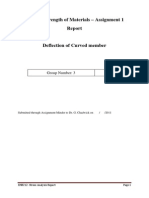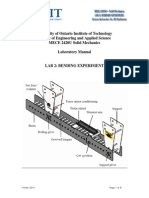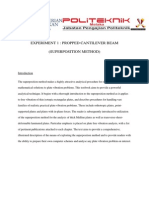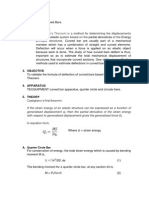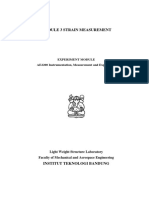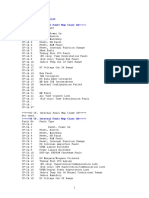Murciano A 2
Murciano A 2
Uploaded by
AaronCopyright:
Available Formats
Murciano A 2
Murciano A 2
Uploaded by
AaronOriginal Description:
Original Title
Copyright
Available Formats
Share this document
Did you find this document useful?
Is this content inappropriate?
Copyright:
Available Formats
Murciano A 2
Murciano A 2
Uploaded by
AaronCopyright:
Available Formats
Cantilever Beam: Strain Measurement, Load,
Uncertainty
Murciano, Aaron
4764 10/3/16
AbstractThis lab involved taking the mass of various weights
using a strain gauge that is mounted to an Aluminum beam using
two methods. The voltage from the strain gage will be amplified
through a strain gage amplifier to increase the signal to get better
results.
Known weights will be used to calibrate the beam scale and
their voltage values will be graphed and be linear. The slope and
uncertainty will be estimated using the Monte Carlo simulation.
The second method will use theories learned in Mechanics of
Materials and the properties of the beam to calculate the load at
the end of the beam. This will only involve calculation based on
the strain gage and not calibrating it.
Index TermsCantilever Beam, Monte Carlo, Strain Gage,
Uncertainty.
I.
INTRODUCTION
HE following lab meant to show that a strain gage can
be used as a transducer to measure different weights
placed at the end of an aluminum beam. By knowing
the properties of the aluminum beam and making precise
measurements, the strain can be used to find the forces acting
on the beam. Also, by calibrating the beam using know
weights, mass can be calculated using the slope of the Monte
Carlo simulation.
A Laptop with LabVIEW will be needed to run a VI that
reads shows the average voltages of the channels. A Multifunction DAQ and a strain gage amplifier with a Wheatstone
bridge will be needed to obtain voltage values from the strain
gage on the beam. A can of soda will be used as the main
object in this lab. The average gulp size will be calculated
using one of the two methods that will be explained further in
the procedures.
Uncertainty will play a huge role in determining which
method is better for which scenario. Uncertainty will be
propagated throughout all the measurements and calculations
made. This will demonstrate the difference between precision
and accuracy.
II. PROCEDURE
The following procedure is paraphrased from the Mechanics
of Materials Lab 2 Instructions manual [1].
Program VI using LabVIEW
Construct a program that inputs Voltage data from the
Multi-function DAQ and outputs the time and required values
needed to complete each part using the subVI. Include the
ability to change acquisition time and the sample rate. Some of
the values will need to be graphed on a dynamically updating
X-Y scatter plot and all the values need to be exported to a
spreadsheet.
4VG
GF V s
V Amp
V G=
Af
=
(1)
(2)
Program the VI to obtain data from the channel averages on
the right side of the subVI. Use Channels 0 and 1 to measure
V s , and the amplified voltage,
the supplied voltage,
V amp , respectively. The VI must have some controls that
offset and condense the amplified voltage to the original gauge
voltage, V G . The strain at the location of the strain gauge
must be calculated with the given gage factor and calculated
voltage values using (1), and plotted on a dynamically
updating plot. The VI must export a spreadsheet of all the data
collected: time (seconds), supplied voltage (V), gauge voltage
(V).
A. Calculating Load Applied using Strain Gauge
Data
Calculate, display and log the load using the strain gage
data, width and thickness of the beam, distance of the strain
gage to center of weight, and the given constants.
B. Calculating Load Applied using Calibration
Constant
Calculate, display and log the load using the calibration
constant calculated later on in the Lab and the V G values.
Mounting Bridge Strain Gage
Apply the strain gauge to the beam around 8 inches from
one of the ends according to the Quarter Bridge Strain Gage
Mounting Steps manual [2]. Place marks on the beam
indicating the center of the strain gauge and the center of
where the masses will be placed. Then clamp the beam to the
cantilever fixture using the Allen driver.
Wiring Strain Gage
Referring to the Lab 2 manual [1], wire the strain gage to
the terminal block accordingly, then to the strain gage
<Section4764_Lab1>
amplifier. Connect wires from the strain gauge amplifier to the
DAQ to channels 0 and 1. Make sure to tare the amplifier
using the zero screws and set is to around 2.5 VDC.
Calibrating the Scale
Weight the calibration weights on a commercial scale. Take
data for 50g, 100g, 200g, 300g, and 350g using
LabVIEW. Make sure to place weights on slowly to minimize
vibration of the beam. Using the MonteCarloSim excel
spreadsheet [3], plot the V G values and the measure
weights and find the slope of the trendline created. This will
be the calibration constant used in calculating the weight of
objects later on.
Weighing Cans mass
Run the VI and weigh the unopened can with the beam
scale 10 times to be able to examine repeatability of
placement. Make sure to place it on the centerline marked
earlier. Then weigh the can on the commercial scale to
compare later on.
Weighing Cans Decreasing Mass due to Gulp
Run the VI and weigh the can with the beam scale while
taking a gulp each time and then placing it back on the scale.
Do this until all the liquid is gone. Take a minimum of 5 data
points for each gulp. Weigh the empty can on the beam scale
and commercial scale. Then find an object that is small and
weigh it on the beam scale and on the commercial scale.
Record weights using strain and calibration methods.
III. RESULTS
The following data includes ranges that are meaningful.
TABLE I
RAW NOISE STANDARD DEVIATION (MV) FOR CHANNEL 0-3
Gain
Window (V)
10
5
2.5
1.25
0.625
0.3125
Channel 0
Channel 1
Channel 2
Channel 3
6.7053
5.7586
5.4126
4.5905
4.2873
4.2063
4.8065
4.0154
3.7465
3.0715
2.8049
2.7372
6.1780
5.3635
5.0281
4.2576
3.9521
3.8908
6.8317
5.8631
5.5634
4.7628
4.4442
4.3252
Fig. 1. Plot of gage voltage (V) against their respective known mass (g) with
trendline.
TABLE II
MEASURED VALUES USED FOR CALCULATIONS
Term
Symbol
Unit
Value
Uncertainty
Gage Factor
Gf
2.1
.005
Amplification
Factor
Af
220
Youngs
Modulus
GPa
69
Yield Point
MPa
240
Width Beam
2.5410-2
2.5410-6
2.946410-3
2.5410-6
0.185
0.0005
m/s2
9.81
Thickness
Beam
Distance gage
to point of
mass
Gravity
Fig. 2. Plot of time (s) against gage voltage (V) of full can 10 times.
TABLE III
MASS OF FULL CAN 10 TIMES CCM VS MOM METHODS
Trial
Mean Mass
CCM (g)
Mean Mass
MOM (g)
364.1289
349.9760
367.6294
353.3443
363.5848
349.4607
<Section4764_Lab1>
364.4751
350.3084
363.1825
349.0794
361.1184
347.0884
362.0204
347.9521
364.3115
350.1632
363.3504
349.2374
10
364.5125
350.3488
TI-84 Calc
284.3
295.8
290.8
IV. DISCUSSION
Only data that was significant was kept. This insignificant
data was due to the rapid changed in voltage as well as human
error during placement of object on the scale.
mdeform=
1000 y b h2
6 ( 9.8 ) L
(10)
Maximum Weight
The maximum weight that can be applied to the beam is
calculated using (10) and the values found in Table II. It is
calculated to be 486.0g.
TABLE IV
MASS OF FULL CAN
Term
Symbol
Unit
Value
Uncertainty
Slope of Trendline
slope
g/V
560,240
22,500
COTS mass
mCOTS
373.3
0.1
Mean voltage
VG
6.49410-4
1.82510-5
Mean mass MOM
mmom
349.7
9.925
Mean mass CCM
mccm
363.8
17.74
1.55
1.62
1.0
Standard Deviation
(MOM)
Standard Deviation
(CCM)
Statistical
Uncertainty
Fig. 3. Plot of time (s) against the gage voltage (V) of the can after each gulp.
TABLE VII
MASS OF OBJECTS USING MOM, CCM, AND COMMERCIAL SCALE
Object
Mass
MOM (g)
Mass
CCM (g)
Mass Scale
(g)
Full Can
349.7
363.8
373.3
Empty Can
14.3
14.9
13.1
Weight of Full Can
The mass of the full can was calculated to be 363.8g using
the proportional relationship of the gage voltage and the
calibration weights. The mass of the calibration weights was
calculated using the commercial scale instead of the values
stamped because there are minor imperfection in the weights
and the tolerance of the commercial scale is much higher. The
mass of the full can was calculated with the slope of Fig. 1.
Using the Monte Carlo simulation and the mean of all the
voltages of the full can from Fig. 2.
The mass of the can was also calculated to be 349.7g using
(1)-(8) which uses the information about the beam and its
stress.
Both of these values are not too far off from each other and
close to the measured value of 373.3g.
Uncertainty
Using (9)-(15), the uncertainty for the CCM was calculated
to be 17.74 and for the MOM method it was 9.925. The
MOM method proved to be the more precise method but the
CCM method was more accurate. Meaning that the MOM
method is very good for calculating differences in voltages but
not accurate it the true voltage.
For calculating the average gulp size the MOM method is
preferred because it looks at changes in mass. For calculating
mass of objects, CCM method is preferred because it gives a
closer accuracy of the true value.
Repeatability of Can Placement
According to Fig. 2. Repeatability of placement may look
like an issue but, this is because it is zoomed in. Table IV
shows that the standard deviations for both MOM and CCM
methods where around 1.6g which is very small compared to
the weight of the objects. Therefore it is not an issue, and this
standard deviation can be minimized by placing the mass more
accurately and consistently on the beam. Also, the statistical
uncertainty of the weight was calculated to be 1 using the
Students t-distribution with a 95% confidence interval.
TABLE V
MASS OF GULP SIZE USING MOM METHOD
<Section4764_Lab1>
Gulp #
Mean Mass
MOM (g)
38.0373
22.7170
33.5987
36.9872
26.7501
34.2650
30.4400
35.7701
30.6584
28.3408
10
Mass=
Symbol
Unit
Value
Uncertainty
Mean Mass MOM
mgulp
31.7564
Standard Deviation
(MOM)
4.876
Gulp Size
According to Table V and VI, the average gulp size was
31.8g with a standard deviation of 4.876. As discussed before
the MOM method was more appropriate for calculating
differences in masses since it had a lower uncertainty. Last
gulp size was not used in the calculations since there was only
a small amount of liquid left.
Weight Empty Can
According to Table VII, both of the masses for the 2
methods were greater than the measured scale mass and this
may have been due to the relatively low weight compared to
the weight of the beam. It wouldve been better to place a
weight under the empty can to increase the total weight being
applied on the beam and the commercial scale. By doing this,
the uncertainty becomes smaller compared to the mass.
The weight of the beam does not affect the calibration
because the beam is deforming elastically and by taring the
gauge voltage before starting, it reduced any initial weight of
the beam. Also, in the calibration of the beam scale, the mass
calculated should be relative to the known calibration weights
which are much heavier than the beam itself, so this reduces
any further error with the initial weight of the beam.
=E
b h3
I=
12
(3)
y=h / 2
(5)
I
y
(6)
M=
W =M /L
(8)
TABLE VIII
CALCULATED VALUES TO FIND MASS OF FULL CAN
TABLE VI
MASS OF AVERAGE GULP SIZE
Term
W
g
(4)
Term
Symbol
Unit
Value
Uncertainty
Strain
2.50210-4
7.06510-6
Stress
Pa
1.727107
487494.3
Moment of
Inertia
m4
5.41410-11
4.710-14
1.4710-3
1.2710-6
Moment at
Gage
Nm
6.3410-1
1.79310-2
Weight
3.43
9.73710-2
Mass MOM
mmom
349.68
Gauge Voltage
VG
6.49410
9.926
-4
1.82510-5
V. CONCLUSION
The Calibration Curve method for calculating the mass of
an object proved to be more accurate according to Table IV
where the actual mass was 373.3g and the calculated was
363.8g with an uncertainty of 17.74. Looking at Fig. 1. This
method also proved to be very consistent. To improve the
uncertainty, more calibration weights should be used to
calculate the slope as well as a stronger gage amplifier.
The mean size of a gulp was 31.8g with a standard
deviation of 4.876. The MOM method was used since it had a
lower uncertainty of 9.925. To reduce the standard deviation,
more data points should be taken to decrease the variations in
each gulp. Also a more accurate way to position the objects on
the beam would greatly reduce uncertainty for both the MOM
and CCM methods while placing them at a farther distance
with a longer beam. Increasing the length of the beam will
increase sensitivity which is better but, the longer it is the
more it will vibrate which did happen during this lab.
It is also apparent in Table VII that there is a larger variation
in mass as the mass increases. For the empty can, there is only
about a 1-2g difference, and for the full can there is a 10-20g
difference. This is because the full can mass is closer to the
max weight before plastic deformation.
(7)
3
<Section4764_Lab1>
4
APPENDIX
UW=
TABLE IX
UNCERTAINTY EQUATIONS
U =
( )
VG
(
(
(U V
2
(U V ) +
S
G f
( )(
2
2
2
U
+
U )2
(
(
E)
E
(9)
UG
) ( )
I
I
U =
U ) +( ) ( U )
(
)
b
h
y
U = ( ) (U )
h
M
M
M
= (
U ) +(
U ) +(
(
(
)
)
I y ) (U )
U=
I
(12
U mass
U mass(CCM )=
( )
mass
= (
W ) (U )
(14)
(14)
mass(ccm)
VG
(U V
mass(15)
(ccm) 2
2
( U slope )
slope
(11)
(10)
UM
VS
( )
W 2
W 2
2
UM) +
U L )2
(
(
M
L
(13)
y
REFERENCES
[1]
[2]
[3]
University of Florida Canvas Site. EML 3301C Mechanics of
Materials Laboratory 2 Fall 2016; Cantilever Beam: Strain
Measurement, Load, Uncertainty. Gainesville, FL. Ridgeway, Shannon.
University of Florida Canvas Site. EML 3301C Quarter Bridge Strain
Gage Mounting Steps. Gainesville, FL. Ridgeway, Shannon.
University of Florida Canvas Site. EML 3301C MonteCarloSim.
Gainesville, FL. Ridgeway, Shannon.
You might also like
- Evaluation of The Torque Measurement SystemDocument6 pagesEvaluation of The Torque Measurement System123andybNo ratings yet
- Strain Gauge Lab ReportDocument13 pagesStrain Gauge Lab ReportMubin Al-Manaf100% (2)
- Reading Rhyme Lesson Sheep in A JeepDocument5 pagesReading Rhyme Lesson Sheep in A Jeepkelsey_criswell100% (1)
- UHV Unit-1 Lecture NotesDocument16 pagesUHV Unit-1 Lecture NotesElaiyarja80% (5)
- Deflection of Curved BarsDocument12 pagesDeflection of Curved Barsfahmie722140% (5)
- AbstractDocument12 pagesAbstractAaron Wong100% (2)
- Mechanics of Materials - Modulus of Elasticity Flexure TestDocument12 pagesMechanics of Materials - Modulus of Elasticity Flexure TestDavid Clark100% (5)
- Aer520 LabsDocument37 pagesAer520 LabsChristopher LauricoNo ratings yet
- Aqualung - Calypso - 1er Étage - Technique ManualDocument15 pagesAqualung - Calypso - 1er Étage - Technique ManualLaurent LeclercqNo ratings yet
- Cantilever Beam: Strain Measurement, Load, Uncertainty: Ronen, Lirun Section 704D 6/13/16Document5 pagesCantilever Beam: Strain Measurement, Load, Uncertainty: Ronen, Lirun Section 704D 6/13/16AaronNo ratings yet
- Thermodynamics: Strain Gauge ExperimentDocument6 pagesThermodynamics: Strain Gauge ExperimentJeromeClintonNo ratings yet
- Lab4.Bending MomentDocument9 pagesLab4.Bending MomentOmar Arabi0% (1)
- Final Lab Report 212-1Document16 pagesFinal Lab Report 212-1Dipak Rajput100% (1)
- Cantilever Lab PDFDocument6 pagesCantilever Lab PDFDuminduJayakodyNo ratings yet
- Bending MomentDocument8 pagesBending MomentMihir Ashar0% (1)
- Experiment 1Document7 pagesExperiment 1FaizYoshNo ratings yet
- Load CellDocument11 pagesLoad CellSiej GoNo ratings yet
- Mech2300 Bending of Beams PracticalDocument11 pagesMech2300 Bending of Beams PracticalJeremy LwinNo ratings yet
- Experimental Testing For AerospaceDocument8 pagesExperimental Testing For AerospaceAndreaCNo ratings yet
- Testing System Development For Creep Characterization of PolymersDocument6 pagesTesting System Development For Creep Characterization of PolymersJames UgoNo ratings yet
- Strain GaugeDocument3 pagesStrain GaugeManthan SinghNo ratings yet
- Lab 2a Dynamic Response of A Mass-Spring System With DampingDocument5 pagesLab 2a Dynamic Response of A Mass-Spring System With DampingPrashant AshishNo ratings yet
- Rel Grav TutorialDocument15 pagesRel Grav TutorialGio AkhalaiaNo ratings yet
- Rocket Stand Final MemoDocument33 pagesRocket Stand Final Memoapi-461820735No ratings yet
- Mechanics LAB AM 317Document10 pagesMechanics LAB AM 317Andrew A AbrahamNo ratings yet
- Back To BackDocument3 pagesBack To BackDragan LazicNo ratings yet
- Physics As Unit 3Document12 pagesPhysics As Unit 3Muaaz IqbalNo ratings yet
- Experiment 3 (Practical 2)Document4 pagesExperiment 3 (Practical 2)Vimal MathivananNo ratings yet
- Instrumentation Lab 5Document7 pagesInstrumentation Lab 5ryan warisNo ratings yet
- 1 Sis AssignmentDocument7 pages1 Sis AssignmentJoseph JoasterNo ratings yet
- Experiment 8: Area - Moment Method: Program Kejuruteraan Mekanikal Fakulti Industri KejuruteraanDocument6 pagesExperiment 8: Area - Moment Method: Program Kejuruteraan Mekanikal Fakulti Industri Kejuruteraanawe_emNo ratings yet
- Portal FrameDocument7 pagesPortal FrameAzzren Azzrain100% (2)
- Lab - Strain Measurement SystemDocument8 pagesLab - Strain Measurement SystemscribdkimNo ratings yet
- Lab Exercise 006BDocument6 pagesLab Exercise 006BEDWIN KHANNo ratings yet
- Paper-Rotating Bending Machine For High Cycle Fatigue TestingDocument7 pagesPaper-Rotating Bending Machine For High Cycle Fatigue TestingAlcidney Valério ChavesNo ratings yet
- Department of Electrical Engineering EE363: Power ElectronicsDocument8 pagesDepartment of Electrical Engineering EE363: Power ElectronicsAbrahan ShahzadNo ratings yet
- Spring Test & Measurement of Bending Stress Using Strain GaugeDocument11 pagesSpring Test & Measurement of Bending Stress Using Strain GaugeAditya KoutharapuNo ratings yet
- EXPERIMENT 2: Principle & Characteristics of Strain GaugeDocument4 pagesEXPERIMENT 2: Principle & Characteristics of Strain GaugeKalisetti AnilNo ratings yet
- Strain Gauge ReportDocument13 pagesStrain Gauge ReportKhaja Moinuddin33% (3)
- Laboratory Design Capacitive Displacement SensorDocument10 pagesLaboratory Design Capacitive Displacement SensorElizabethNo ratings yet
- Vibration Lab 2Document14 pagesVibration Lab 2lili aboudNo ratings yet
- Portal FrameDocument7 pagesPortal FrameMuhammad Hasrul HasnanNo ratings yet
- Calibration of Load CellDocument3 pagesCalibration of Load Cellpammy313100% (2)
- Calibration of Metal TapesDocument16 pagesCalibration of Metal Tapesarabcal100% (2)
- Strain Gauge (Metrology) PDFDocument10 pagesStrain Gauge (Metrology) PDF21bme005No ratings yet
- Lab 4c: Driven Mass-Spring System With Damping: 58:080 Experimental EngineeringDocument24 pagesLab 4c: Driven Mass-Spring System With Damping: 58:080 Experimental EngineeringAhmed H HusseinNo ratings yet
- Curved BarDocument11 pagesCurved BarJonathan Boyd100% (1)
- Modul 3 Strain Measurement v2 PDFDocument11 pagesModul 3 Strain Measurement v2 PDFFachrudin HanafiNo ratings yet
- 2.737 Mechatronics Laboratory Assignment 4: AC-Driven and Demodulated Electronic ScaleDocument4 pages2.737 Mechatronics Laboratory Assignment 4: AC-Driven and Demodulated Electronic ScaleSachin Kumar BNo ratings yet
- Lab1 SampleDocument20 pagesLab1 SampleLee MingHweeNo ratings yet
- Physics 1 SPH 2170: Precision MeasurementsDocument29 pagesPhysics 1 SPH 2170: Precision MeasurementsJuan SomoNo ratings yet
- Am LabDocument22 pagesAm LabJayavel123No ratings yet
- Design Optimization of 25mm Diameter Strain Gauge Balance For Wind Tunnel ApplicationDocument6 pagesDesign Optimization of 25mm Diameter Strain Gauge Balance For Wind Tunnel ApplicationIJIRSTNo ratings yet
- EXP3Document16 pagesEXP3ahmadmn_scribdNo ratings yet
- Materials Lab Tensile Strength MachineDocument20 pagesMaterials Lab Tensile Strength Machineamuaz9217No ratings yet
- Lab Section 7 - Group 3Document19 pagesLab Section 7 - Group 3naimNo ratings yet
- Young Modulus ExpDocument9 pagesYoung Modulus ExpUmarKhalifNo ratings yet
- FA20 Lab 2 Procedure Discussion Uncertainty PDFDocument30 pagesFA20 Lab 2 Procedure Discussion Uncertainty PDFAkaash SharmaNo ratings yet
- Lab ManualDocument14 pagesLab ManualBenni AmirNo ratings yet
- Cantilever Beam Experiment B58SBDocument9 pagesCantilever Beam Experiment B58SBSunNo ratings yet
- A First Course in Dimensional Analysis: Simplifying Complex Phenomena Using Physical InsightFrom EverandA First Course in Dimensional Analysis: Simplifying Complex Phenomena Using Physical InsightNo ratings yet
- Standard-Slope Integration: A New Approach to Numerical IntegrationFrom EverandStandard-Slope Integration: A New Approach to Numerical IntegrationNo ratings yet
- Design and Implementation of Portable Impedance AnalyzersFrom EverandDesign and Implementation of Portable Impedance AnalyzersNo ratings yet
- Guidelines For Seminar Paper of BBA BBM 1Document6 pagesGuidelines For Seminar Paper of BBA BBM 1BISHALNo ratings yet
- BBGP4103 Consumer BehaviourDocument6 pagesBBGP4103 Consumer Behaviournartina sadzilNo ratings yet
- Specification / Required Items Description For Mazzanine Floor Floor Frame Structure PreparationDocument3 pagesSpecification / Required Items Description For Mazzanine Floor Floor Frame Structure PreparationVijay RanaNo ratings yet
- r10 Bts Fault Code List-1Document11 pagesr10 Bts Fault Code List-1bettyNo ratings yet
- HypothesisDocument19 pagesHypothesisYixuan PENGNo ratings yet
- InsulRoof Tech Data SheetDocument2 pagesInsulRoof Tech Data SheetSampath BandaraNo ratings yet
- General Visual Inspection Procedure With Rov Class XXXDocument2 pagesGeneral Visual Inspection Procedure With Rov Class XXXErnesto Farias100% (1)
- BSBFIN601 Project PortfolioDocument13 pagesBSBFIN601 Project PortfolioPrabu Jung AdhikariNo ratings yet
- KW2000 Supported ServicesDocument51 pagesKW2000 Supported Servicesmsnshr100% (1)
- Esempi Domande e Argomenti Prova OraleDocument3 pagesEsempi Domande e Argomenti Prova OraleMarina PriestNo ratings yet
- The nonprofit marketing guide High impact low cost ways to build support for your good cause 1st Edition Kivi Leroux Miller all chapter instant downloadDocument61 pagesThe nonprofit marketing guide High impact low cost ways to build support for your good cause 1st Edition Kivi Leroux Miller all chapter instant downloadeplidapeng100% (3)
- Transverse Tunnel Thrusters: Fincantieri / Marine Systems and ComponentsDocument6 pagesTransverse Tunnel Thrusters: Fincantieri / Marine Systems and ComponentsnaufragatoNo ratings yet
- Prepaid Call Flow Taffic CasesDocument237 pagesPrepaid Call Flow Taffic CasesMenow ShutterNo ratings yet
- Mid-Term Test With AnswersDocument9 pagesMid-Term Test With Answersct442008100% (1)
- Important Concepts Relating To Research DesignDocument2 pagesImportant Concepts Relating To Research Designmbaguy123100% (1)
- A Review of Service Quality ModelsDocument8 pagesA Review of Service Quality ModelsJimmiJini100% (1)
- Project On Causes of Cracks in Building and Ways of PreventionDocument110 pagesProject On Causes of Cracks in Building and Ways of PreventionTUURINUNBA SAANNo ratings yet
- RomanticismDocument7 pagesRomanticismAhmed ZidanNo ratings yet
- Holistic PerspectiveDocument1 pageHolistic PerspectiveFlorina Nadorra RamosNo ratings yet
- MSI 880GM-E43 Motherboard ManualDocument92 pagesMSI 880GM-E43 Motherboard ManualRommuel Sam Bulda MamuricNo ratings yet
- Lista de Precios Corsair 16082021Document2 pagesLista de Precios Corsair 16082021andreaNo ratings yet
- Yonatan SisayDocument82 pagesYonatan Sisayhabtamu fentaNo ratings yet
- TuplesDocument37 pagesTuplesgodochetimothy10No ratings yet
- EL431 Power System Analysis Lab: Final Term Exam Max Time: Max Marks: Lab InstructorDocument11 pagesEL431 Power System Analysis Lab: Final Term Exam Max Time: Max Marks: Lab InstructorHamza NagraNo ratings yet
- Complete The Following Sentences by Filling in The Blanks With The Correct Simple Tense Form of The Verb in The ParenthesesDocument3 pagesComplete The Following Sentences by Filling in The Blanks With The Correct Simple Tense Form of The Verb in The ParenthesesJomar Dela CruzNo ratings yet
- CE8702 Railways Airports Ducks and Harbour EngineeringDocument2 pagesCE8702 Railways Airports Ducks and Harbour EngineeringNagarajanNo ratings yet
- Oa What Are Business FlowsDocument5 pagesOa What Are Business Flowssmogharabi55No ratings yet












